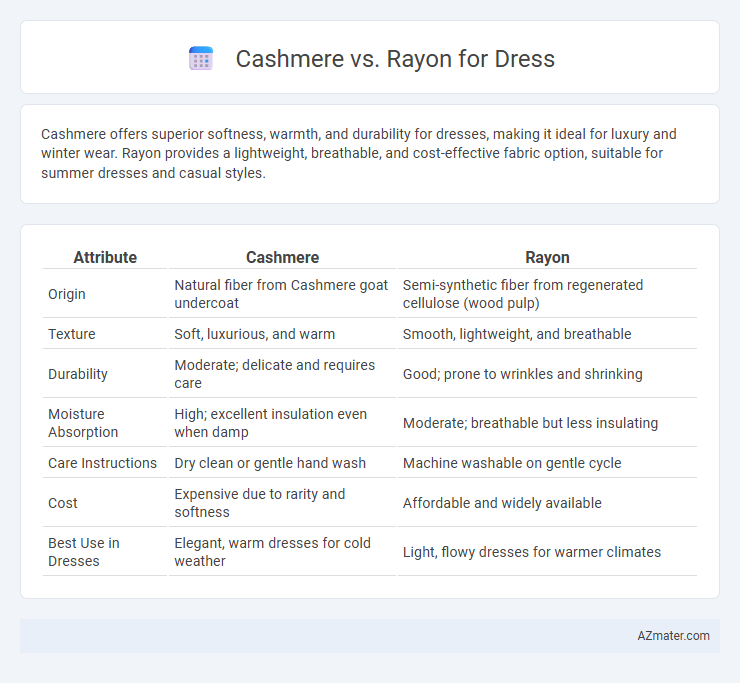Cashmere offers superior softness, warmth, and durability for dresses, making it ideal for luxury and winter wear. Rayon provides a lightweight, breathable, and cost-effective fabric option, suitable for summer dresses and casual styles.
Table of Comparison
| Attribute | Cashmere | Rayon |
|---|---|---|
| Origin | Natural fiber from Cashmere goat undercoat | Semi-synthetic fiber from regenerated cellulose (wood pulp) |
| Texture | Soft, luxurious, and warm | Smooth, lightweight, and breathable |
| Durability | Moderate; delicate and requires care | Good; prone to wrinkles and shrinking |
| Moisture Absorption | High; excellent insulation even when damp | Moderate; breathable but less insulating |
| Care Instructions | Dry clean or gentle hand wash | Machine washable on gentle cycle |
| Cost | Expensive due to rarity and softness | Affordable and widely available |
| Best Use in Dresses | Elegant, warm dresses for cold weather | Light, flowy dresses for warmer climates |
Understanding Cashmere and Rayon: Key Differences
Cashmere is a natural, luxurious fiber derived from the soft undercoat of cashmere goats, known for its exceptional warmth, softness, and durability, making it ideal for high-end dress fabrics. Rayon, a semi-synthetic fiber made from regenerated cellulose, offers a smooth, breathable texture with excellent drape but lacks the insulating properties and long-term resilience of cashmere. Understanding these fundamental differences in fiber origin, texture, and performance helps in selecting the appropriate material for dresses based on comfort, appearance, and function.
Origins and Production Processes
Cashmere originates from the undercoat of Kashmir goats found primarily in regions like Mongolia, China, and Nepal, characterized by a meticulous hand-combing process to collect the soft fibers. Rayon, a semi-synthetic fabric, is produced by chemically treating cellulose extracted from wood pulp, primarily sourced from fast-growing trees such as eucalyptus and pine. The production of cashmere involves natural, labor-intensive methods preserving fiber quality, whereas rayon manufacturing relies on industrial chemical processes designed for mass production and versatility in fabric texture.
Texture and Feel: Comfort Comparison
Cashmere offers an exceptionally soft and luxurious texture with a natural warmth that feels gentle against the skin, making it ideal for comfort in cooler weather. Rayon provides a smooth, silky feel that is lightweight and breathable, enhancing comfort in warmer conditions. While cashmere excels in softness and insulation, rayon stands out for its moisture-wicking properties and versatility in draping.
Breathability and Climate Suitability
Cashmere offers excellent breathability and insulation, making it ideal for cooler climates where warmth and moisture-wicking are essential. Rayon, being a semi-synthetic fiber derived from cellulose, provides good breathability and moisture absorption, making it suitable for warm and humid environments. Dresses made from rayon allow for better airflow and comfort in hot weather, whereas cashmere dresses excel in retaining heat during colder seasons.
Durability and Long-Term Wear
Cashmere offers superior durability and long-term wear due to its natural fiber composition, which resists pilling and maintains softness over time. Rayon, a semi-synthetic fiber, tends to weaken with repeated washing and is more prone to shrinking and losing shape, making it less ideal for longevity. Choosing cashmere dresses ensures lasting quality and resilience, especially for frequent use.
Maintenance and Cleaning Requirements
Cashmere dresses require delicate maintenance, including hand washing with mild detergent or dry cleaning to preserve their softness and prevent damage. Rayon dresses often demand gentle washing in cold water or professional cleaning due to their tendency to shrink and lose shape when exposed to heat or harsh detergents. Proper storage, such as folding cashmere to avoid stretching and hanging rayon carefully, is essential to maintain the fabric's longevity and appearance.
Sustainability and Environmental Impact
Cashmere production often involves overgrazing, leading to soil degradation and habitat loss, raising significant sustainability concerns compared to rayon, which is derived from cellulose fibers typically sourced from fast-growing trees. Rayon manufacturing requires intensive chemical processing that can pollute waterways if not properly managed, though advancements in closed-loop production methods are improving its environmental footprint. Selecting sustainably sourced and responsibly processed fibers is critical to minimizing the overall ecological impact of cashmere and rayon dresses.
Price Points and Value for Money
Cashmere dresses typically command higher price points due to the luxury fiber's softness, warmth, and durability, making them a premium investment for long-term wear. Rayon dresses are generally more affordable, offering budget-friendly options that mimic the drape and feel of natural fibers but lack the insulating properties and longevity of cashmere. The value for money in cashmere lies in its timeless elegance and comfort, while rayon suits those prioritizing style variety and cost efficiency.
Ideal Occasions: When to Choose Cashmere or Rayon
Cashmere dresses are ideal for formal events and cold-weather occasions due to their luxurious warmth and soft texture. Rayon dresses suit casual gatherings and warm climates, offering breathability and lightweight comfort. Selecting cashmere enhances elegance and coziness, while rayon provides versatility and ease of movement in everyday wear.
Final Verdict: Which is Better for Your Dress?
Cashmere offers unmatched softness, warmth, and luxury, making it ideal for high-end, elegant dresses suited for cooler weather. Rayon provides a lightweight, breathable alternative with excellent drape and affordability, perfect for versatile, casual, or summer dresses. Choosing between cashmere and rayon depends on prioritizing comfort and luxury versus cost-effectiveness and breathability in your dress selection.

Infographic: Cashmere vs Rayon for Dress
 azmater.com
azmater.com